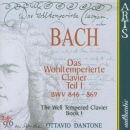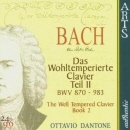|
|
Well Tempered Clavier Books I & II BWV 846-893
Ottavio Dantone (Harpsichord)
Review: WTC by Ottavio Dantone
|
K-1 |
Bach: Bach: Das Wohltemperierte Clavier, Teil I, BWV 846-869 (The Well Tempered Clavier - Book 1) |

|
|
WTC 1: 24 Preludes & Fugues BWV 846-869 |
|
Ottavio Dantone (Harpsichord) |
|
Arts Music |
Jun 2000 |
2-CD / TT: 123:49 |
|
Recorded at Sala del Refettorio de S. Vitale, Ravenna, Italy.
Buy this album at: Amazon.com | Amazon.com |
|
K-2 |
Bach: Bach: Das Wohltemperierte Clavier, Teil II, BWV 870-893 (The Well Tempered Clavier - Book 2) |

|
|
WTC 2: 24 Preludes & Fugues BWV 870-893 |
|
Ottavio Dantone (Harpsichord) |
|
Arts Music |
Jun 2000 |
2-CD / TT: 146:04 |
|
Recorded at Sala del Refettorio de S. Vitale, Ravenna, Italy.
Buy this album at: Amazon.com |
|
Kirk McElhearn wrote (December 8, 2001):
Ottavio Dantone, an Italian harpsichordist and conductor of no mean talent, plays Bach¹s masterwork the Well-Tempered Clavier with drive and vigor. His playing is energetic and lively; this is no dry academic version of these preludes and fugues. It is interesting that few Italian harpsichordists have stood out in this repertoire.
One is immediately taken aback by the magnificent sound of the harpsichord used on this recording. Not only is the instrument itself - a copy of a Blanchet by Olivier Fadini - sparkling and rich, but the recording is extraordinary. The harpsichord sounds as if it is in the same room with the listener; its treble end is bright without being harsh, and its bass notes resonate with great warmth. The recording is excellent. There is a picture of Dantone playing during the recording sessions, which shows his harpsichord in a spacious room, far from the walls, which probably also has high ceilings. The instrument is recorded by two microphones placed in front of and above the harpsichord. This gives the recording a space and amplitude that is rare; the resonance of the room is subtle and highlights the harpsichord without being intrusive. Curiously, Dantone uses different temperaments for the two books: the first is Werckmeister III, and the second is Kirberger. This is not easily noticeable when listening to the recordings, and one could wonder why he would have done this.
Dantone is a bit brash, though. At the end of the first prelude, which most people have heard many times, he throws in a little trill, something not in the original score, yet not entirely out of place. It is as if he is saying, at the end of the very first and most famous piece in this set, that he is here to show a different vision of these works.
His playing covers the full range of styles and emotions that this music calls for. In most cases, he seems to be in perfect symbiosis with the music - he never forces the music to fit his style, but rather adapts himself to each different piece flawlessly.
His performance of the E minor prelude in book I is very exciting; his tempo is a bit faster than many performers, and he gives great clarity to the two voices - the arpeggiating bass line is very present, but not overpowering, and the treble voice is very playful and gay.
He can be forceful and energetic, as in the F minor fugue in book I, and then light and delicate, as in the F sharp minor prelude and fugue in the same book. Dantone adapts very well to the different styles Bach used in this varied work.
Dantone ornaments very well, never overdoing it; even in the G minor prelude of book I, with its long trills, which Dantone plays at a relatively slow tempo, the ornaments sound just and fit well with the music.
Dantone opens book two with an exceptionally tender interpretation of the first prelude; this work is often played too quickly, too aggressively, but Danton is very humble in his performance of this piece, he lets the music take over rather than directing it too rigidly.
His performance of the C sharp major prelude is a gem - his ornamentation is fresh and delightful, his phrasing subtle and inventive. He takes this piece and gives it new life, infusing it with joy and happiness. Even the following fugue takes on this tone, in spite of the radical difference between the two pieces.
One could say that Dantone has almost a French sound in the preludes; the F minor prelude in book II is a good example of this. He plays the notes slightly detaché, with a very ³precious² touch and ornamentation. His rhythms are always very clear and incisive, and his phrasing is excellent.
In the fugues, Dantone provides a clarity of the different voices which is rare indeed. His rhythms are lively, his tempi appropriate, but, above all, what comes through most is a deep joy. His performances are far from the didactic fugues played by some artists; he shows that these works are, while built on strict rules and counterpoint, eminently enjoyable.
This is a one of the best recordings available of the Well-Tempered Clavier for harpsichord. The combination of the beautiful instrument, excellent recording and uniquely personal interpretation puts this among the few truly indispensable recordings of this work on harpsichord. Ottavio Dantone is certainly a harpsichordist to follow in the coming years. This set announces a great musician. |
|
|
|